
Products & Equipment
Pits & Quarries
New wash plant doubles output
February 22, 2010 By Andy Bateman
In 2003, a portable sand plant made its Canadian debut at Drain
Brothers Excavating Limited. The same company’s operation is again the
venue for the Canadian debut of a new sand plant with double the
capacity to meet rising demand.
In 2003, a portable sand plant made its Canadian debut at Drain Brothers Excavating Limited. The same company’s operation is again the venue for the Canadian debut of a new sand plant with double the capacity to meet rising demand.
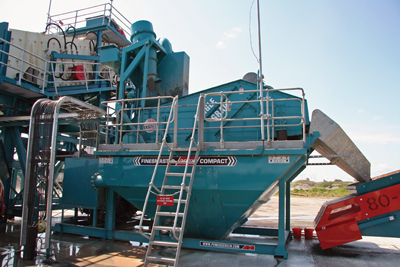 |
|
| The Terex Powerscreen Finesmaster 200X Compact sand recovery plant is designed to produce one grade of washed sand at a typical throughput rate of 200 tonnes-h.
|
A new wash plant set up recently went into production at the company’s Norwood sand and gravel operation and teams a high capacity rinsing screen with the new sand recovery plant. Production supervisor Craig Oliver explains that the aggregate operations of Drain Bros. have traditionally supplied aggregates to the company’s asphalt, sewer and water main, and construction divisions, as well as the Peterborough market 35 km to the west. However, external demand for the company’s washed aggregates has been steadily increasing in recent years, with products now being shipped as far as 160 km to hot mix plants in the eastern Greater Toronto Area (GTA). One of the factors driving this demand is Drain Bros.’ recent acquisition of the former 3M traprock quarry located 5 km east of Havelock, a designated MTO source of aggregates for surface asphalt mixes.
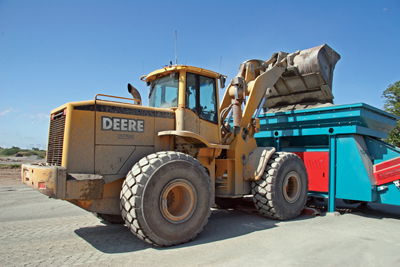 |
|
| Feed material was supplied to the plant by a John Deere 744 H wheel loader while a second 744 H stockpiled finished product on the paved area surrounding the plant.
|
The new wash plant will process sized feed materials at up to 300 tonnes-h from a number of company owned sources including the Norwood pit, Havelock quarry and other limestone and red granite quarries. The production capacity of washed coarse aggregates has been doubled by using a 6 by 20 rinsing screen compared to the previous 5 by 12 unit, while the sand plant has doubled washed fine aggregate capacity to about 200 tonnes-h. The sand plant replaces a Powerscreen Finesmaster 120 unit that was being decommissioned at the time of Aggregates & Roadbuilding’s visit. Oliver notes that, although the old plant has served the operation well, it no longer provided the capacity to meet the increased demand.
Process flow
On the day visited, the new plant had just begun producing washed fine asphalt aggregate, utilizing 100 per cent crushed rock sized at 7.9 mm to 6.3 mm minus from the Havelock quarry. The plant was fed by a John Deere 744 H wheel loader charging an 11.5 m³ capacity feed hopper. From there, the hopper’s variable feeder ensured that a steady supply of material was maintained onto the 25.9 m long and 914 mm wide feed conveyor feeding a 6 by 20 Terex Minerals Processing Systems triple deck rinsing screen. At the screen, all of the relatively small feed material passed through the screen’s 25 mm opening top deck and onto the 13 mm square wire cloth of the middle deck, where any residual oversize in the feed was scalped off to ensure tight product gradation. At the same time, any material retained on the screen’s 6.3 mm opening bottom deck was stockpiled as minus 8 mm plus 6.3 mm chip, while the majority of the small sized feed and water passed through the bottom deck into a slurry tank below. From there, sand slurry was pumped to the Terex Powerscreen Finesmaster 200X Compact sand recovery plant where it was first directed to the plant’s twin cyclones. Particles sized at 75 micron and larger discharged from the cyclones’ underflow onto the plant’s dewatering screen, while silt and clay fines (sized at 75 microns and smaller) were piped from the cyclone’s overflow to the operation’s three stage slurry ponds. In normal operation, the cyclones reduced the amount of minus 75 microns material in the feed material from about 10 to between three and four per cent.
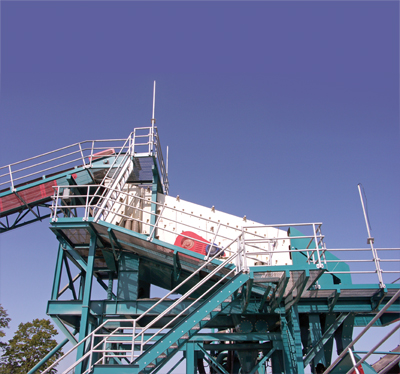 |
|
| The production capacity of washed coarse aggregates has been doubled by the new wash plant’s 6 by 20 Terex Minerals Processing Systems triple deck rinsing screen.
|
Finished sand product from the dewatering screen was discharged onto a fixed 24.4 m long and 914 mm wide fixed product stacker and stockpiled by a second John Deere 744 H wheel loader on the paved area surrounding the plant. Scheduled running hours for the plant are 5 a.m. to 5 p.m. Monday to Friday, with intermittent Saturday hours as required.
Safety and quality measures
The new setup demonstrates attention to detail at the design stage with respect to both safety and product quality. On safety, pinch points are well guarded, while wide catwalks and extensive safety railings help to reduce the risk of slips and falls. As an additional safety measure, the plant is frequently washed down to prevent any debris buildup on catwalks or stairways. The plant has also been set up on an elevated concrete pad and the surrounding area paved with asphalt. As a result, the site is well drained to eliminate the puddles that often form around wash plants and become a slip hazard in cold weather.
Good site drainage also delivers benefits in terms of product quality by facilitating the moisture drainage out of product stockpiles. In many operations, finished product stockpiles on unpaved surfaces tend to retain water in the bottom of the pile, particularly, stockpiles of fine sized aggregates. Dryer aggregates are also popular with customers who are buying product rather than water. Where the end user is a hot mix asphalt plant, lower moisture content in the feed aggregates also means significantly less energy required to dry the aggregates during the asphalt production process.
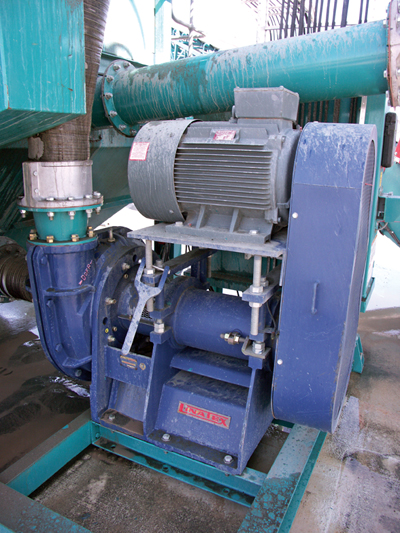 |
|
| The Linatex Linapump 111r pump on the sand plant is driven by an 88.5 hp electric motor supplied by Lawrcon.
|
The smooth paved surface around the plant and paved access to it also deliver a number of additional benefits. The likelihood of mud tracking from vehicle tires into the finished product is reduced, while the paved surfaces are easier to keep clean – making for reduced dust generation – and are easier on both trucks and their drivers. Oliver adds that plans are in hand to extend the paved area so as to provide additional space for product stockpiling. Still on product quality, it is also the practice to keep stockpile heights low to reduce the segregation that can occur in large conical stockpiles. To switch feedstock, any remaining inventories underneath the product stackers are removed and stockpiled elsewhere.
Maintenance and support equipment
Turning to wash plant repair and maintenance, Oliver expects lower repair costs from the new sand plant, as the new design eliminates the bucket wheels of the old plant, thereby eliminating the wear points that were susceptible to the highly abrasive Havelock quarry rock. On the rinsing screen, normal steel media is being used at present and a comparison with alternative media such as urethane may be tried in the future. Those items aside, the repair and maintenance of the new set up is expected to be similar to the old set as a number of support equipment items have been retained. The new plant utilizes the portable power unit from the previous setup, with a Caterpillar 3306 genset driving a 210 kW generator. The water supply system is also generally similar and utilizes the same two settling ponds and a suction pond from which fresh water is drawn. This efficient closed circuit system utilizes a spring to supply make up water to the suction pond.
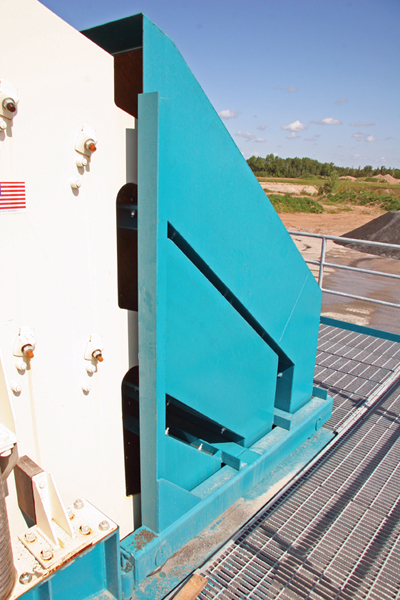 |
|
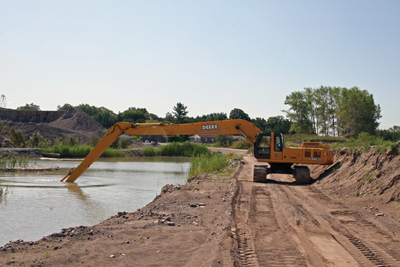 |
|
| Top: The 6 by 20 Simplicity triple deck rinsing screen is equipped with a rolling assembly for the section of the discharge chutes above the catwalk. This design provides front access for cloth changes and screen maintenance. Bottom: The 18.5 m reach of the operation’s John Deere 330C LC excavator facilitates settling pond clean-out.
|
Sand plant details
Manufacturer’s literature indicates that the upgraded Powerscreen Finesmaster 200X Compact sand recovery system removes silts, slimes and clay below 200 mesh (75 micron). The plant is capable of producing one grade of washed sand at a typical throughput rate of 200 tonnes-h and is designed to work in conjunction with the Powerscreen washing range. The upgraded Finesmaster 200X Compact unites a rubber lined centrifugal slurry pump, twin 24 inch hydro cyclones, which classify at approximately 200 mesh (75 micron), and a self regulating slurry collection tank. The tank has a built in float system and a high frequency 6 by 15 dewatering screen fitted with polyurethane modular mats all on a single chassis. This compact, high-performance sand/fines recovery unit is of heavy-duty construction with all wear areas rubber lined and, through optimum efficiency, is said to offer an exceptionally high level of saleable product recovery. The high frequency 6 by 15 dewatering screen reduces moisture content to between 10 and 15 per cent, producing a finished product that is easily stockpiled and ready for dispatch. The cyclones have a full width underflow distribution box giving an even flow to the screen. The dewatering screen has 0.5 mm openings and is driven by two low noise 8.3 hp vibratory motors operating at 960 rpm. Applications listed for the plant by Powerscreen include all forms of concrete, mortar and asphalt sands, quarry dust / crushed fines, lake and beach sands, silica sand for the glass industry, golf course sands, filter bed sands, recycled materials, iron ore and most materials that need to be washed.
Print this page